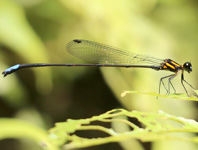Abstract
The turbulent history of Warsaw resulted in great losses in Polish zoological museums and archives especially during First and Second World War (Kazubski 1996; Fedorowicz & Feliksiak 2016). However, before 1939 Warsaw’s zoological collection deposited in the State Zoological Museum (now called: the Museum and Institute of Zoology Polish Academy of Sciences in Warsaw—MIZ PAS), especially the department of neotropics, used to be one of the best developed and well cataloged collections in Europe. There were also many holotypes of mammal species stored here after Polish expeditions to the neotropics. As a result of these events current bibliography and on-line databases (GBIF, VertNet) up to now did not mention the location of holotypes of collected taxa or even recognize them as missing (Ramírez-Chavez et al. 2014; Patton et al. 2015). We reviewed the collection to estimate the presence and status of the surviving descriptive types (holotypes). The aim of this study was to order our knowledge about the holotypes taking into account especially information about lost specimens and to explain the contradictory information about their status in the present. In 2015–2016 all type specimens in the MIZ PAS collection of neotropical mammals were revised. During revision relevant information from specimen labels was compared with the data provided in the original descriptions contained in publications from the end of nineteenth century (Taczanowski 1881; Thomas 1884; Stolzmann 1885; Thomas 1893; 1894). The results were compared with the collection databases of the Natural History Museum in London (http://data.nhm.ac.uk). Systematics and species nomenclature were followed by Wilson & Reeder (2005). Zoological nomenclature types were followed by International Commission on Zoological Nomenclature (ICZN). The results of the revision are presented as a systematic list.
References
Cabrera, A. (1961) Catálogo de los mamíferos de América del Sur. Revista del Museo Argentino de Ciencias Naturales “Bernardino Rivadavia” e Instituto Nacional de Investigación de las Ciencias Naturales, Ciencias Zoológicas, 4, 309–732.
Fedorowicz, Z. & Feliksiak, S. (2016) 150-lecie Gabinetu Zoologicznego w Warszawie (1818–1968) [Eds. Daszkiewicz, P., Iwan, D., Kowalski, H., Mierzwa-Szymkowiak, D. & Zaborowski, R.]. Memorabilia Zoologica, New Series, 1, 1–202.
Feliksiak, S. (1987) Sztolcman Jan. In: Feliksiak, S. (Ed.), Słownik biologów polskich. Polskie Wydawnictwo Naukowe, Warszawa, pp. 529–530.
Gardner, A.L. & Carter, D.C. (1972) A review of the Peruvian species of Vampyrops (Chiroptera: Phyllostomatidae). Journal of Mammalogy, 53, 72–82.
https://doi.org/10.2307/1378828GBIF (2017) Global Biodiversity Information Facility. Available from: http://gbif.org/ (accessed 9 February 2017)
International Commission on Zoological Nomenclature (1999) International code of zoological nomenclature. 4th Edition. International Commission on Zoological Nomenclature London, 306 pp.
Kazubski, S.L. (1996) The history of the Museum and Institute of Zoology, PAS. Bulletin of the Museum and Institute of Zoology PAS, 1, 7–19.
Mierzwa-Szymkowiak, D. & Breure, A.S.H. (2017) Inside and outside Neotropics: Three Polish naturalists during the late 19th and early 20th century. Archives of Natural History, 44, 151–158.
https://doi.org/10.3366/anh.2017.0423Patton, J.L., Pardiñas, U.F.J. & D’Elia, G. (Eds.) (2015) Mammals of South America. Vol. 2. Rodents. University of Chicago Press, Chicago, 1384 pp.
Piechnik, Ł. & Kurek, P. (2016) Ssaki neotropików odkryte przez polskich naturalistów [Neotropical mammals discovered by Polish naturalists]. Instytut Botaniki PAN, Kraków, 356 pp.
Ramírez-Chavez, H.E., Arango-Guerra, H.L. & Patterson, B.D. (2014) Mustela africana (Carnivora: Mustelidae). Mammalian Species, 46, 110–115.
https://doi.org/10.1644/917.1Sztolcman, J. (1883) Wspomnienia z podróży po Peru. Wszechświat, 2, 760.
Stolzmann, J. (1885) Description d’un nouveau Rongeur du genre Caelogenys. Proceedings of the Zoological Society of London, 11, 161–167.
Taczanowski, W. (1881) Description d’une nouvelle espèce du genre Mustela du Pérou nord-oriental. Proceedings of the Zoological Society of London, 1881, 835–836.
Thomas, O. (1884) On a collection of Muridae from Central Peru. Proceedings of the Zoological Society of London, 1884, 447–458.
Thomas, O. (1893) On some mammals from central Peru. Proceedings of Zoological Society of London, 1893, 333–341.
Thomas, O. (1894) Descriptions of some new neotropical Muridae. Annals and Magazine of Natural History, Series 6, 14, 346–366.
Wilson, D.E. & Reeder, D.M. (Eds.) (2005) Mammal Species of the World: A taxonomic and geographic reference. 3rd Edition. Johns Hopkins University Press, Baltimore, 2142 pp.
Vert Net (2017) Available from: http://vertnet.org/ (accessed 7 February 2017)
Woods, C.A. & Kilpatrick, C.W. (2005) Infraorder Hystricognathi. In: Wilson, D.E. & Reeder, D.M. (Eds.), Mammal species of the world: A taxonomic and geographic reference. Third edition. Johns Hopkins University Press, Baltimore, pp. 1560.

